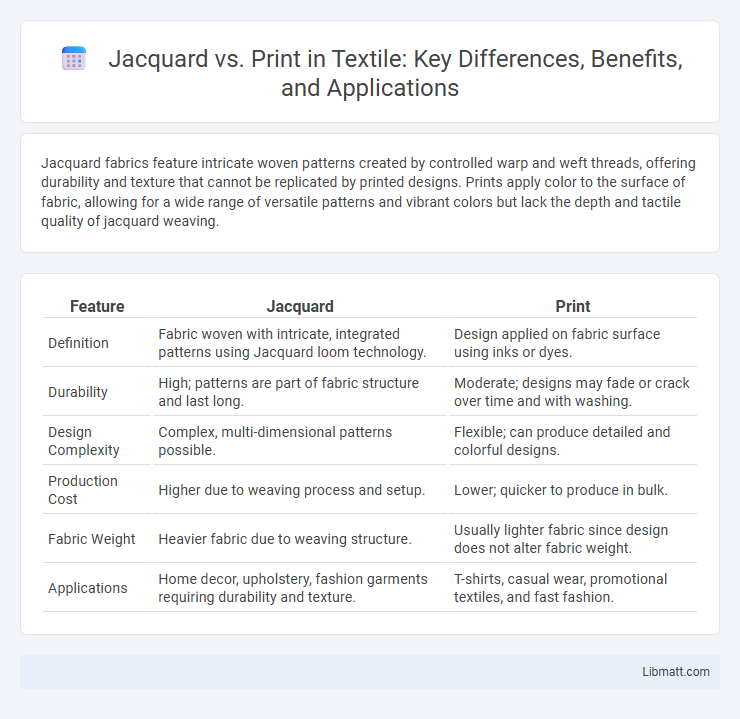Jacquard fabrics feature intricate woven patterns created by controlled warp and weft threads, offering durability and texture that cannot be replicated by printed designs. Prints apply color to the surface of fabric, allowing for a wide range of versatile patterns and vibrant colors but lack the depth and tactile quality of jacquard weaving.
Table of Comparison
| Feature | Jacquard | |
|---|---|---|
| Definition | Fabric woven with intricate, integrated patterns using Jacquard loom technology. | Design applied on fabric surface using inks or dyes. |
| Durability | High; patterns are part of fabric structure and last long. | Moderate; designs may fade or crack over time and with washing. |
| Design Complexity | Complex, multi-dimensional patterns possible. | Flexible; can produce detailed and colorful designs. |
| Production Cost | Higher due to weaving process and setup. | Lower; quicker to produce in bulk. |
| Fabric Weight | Heavier fabric due to weaving structure. | Usually lighter fabric since design does not alter fabric weight. |
| Applications | Home decor, upholstery, fashion garments requiring durability and texture. | T-shirts, casual wear, promotional textiles, and fast fashion. |
Introduction to Jacquard and Print Fabrics
Jacquard fabrics are woven with intricate patterns directly into the material using a specialized loom, offering durability and a textured design that maintains its detail over time. Print fabrics, on the other hand, feature designs applied on the surface through dyeing or printing techniques, allowing for vibrant colors and a wide range of patterns but with less texture and longevity. Understanding the difference between Jacquard and print fabrics helps you choose the best option for your project, balancing visual appeal and functional qualities.
Understanding Jacquard Weaving
Jacquard weaving involves creating intricate patterns directly into fabric using a specialized loom that controls individual warp threads, resulting in textured and durable designs. Unlike print methods that apply color on the fabric surface, Jacquard integrates design during the weaving process, enhancing longevity and fabric depth. Understanding Jacquard weaving helps you appreciate the complexity and quality differences compared to traditional printed textiles.
What is Printed Fabric?
Printed fabric involves applying designs, colors, or patterns directly onto textile surfaces using techniques like screen printing, digital printing, or block printing. This method allows for intricate, multicolored, and highly detailed motifs that can be customized with ease, offering versatility across various fabric types. Unlike woven designs, printed patterns sit on the fabric's surface, providing vibrant visuals without altering the fabric's texture or structure.
Key Differences Between Jacquard and Print
Jacquard fabric is characterized by intricate patterns woven directly into the textile using a Jacquard loom, resulting in a textured, durable design that integrates with the fabric's structure. In contrast, printing applies designs onto the fabric surface using inks or dyes, allowing for more vivid colors and detailed imagery but with less texture and long-term durability. The key differences lie in production methods, texture, durability, and design longevity, with Jacquard offering a richer texture and print delivering greater color variety and detail.
Advantages of Jacquard Fabrics
Jacquard fabrics offer intricate, durable patterns woven directly into the textile, ensuring long-lasting designs that don't fade or peel like prints. They provide a luxurious texture and greater depth, enhancing the overall aesthetic and feel of your garments. This weaving technique also allows for complex, multi-dimensional designs that are impossible to replicate with standard printing methods.
Benefits of Print Techniques
Print techniques provide unparalleled versatility in design, enabling vibrant colors and intricate patterns on various fabrics with cost-effective scalability. These methods allow for rapid production and customization, making them ideal for limited editions or fast fashion cycles. Print technology also supports eco-friendly practices by reducing waste through digital precision and selective application.
Common Uses for Jacquard vs Print
Jacquard fabric is commonly used in high-end upholstery, fashion garments, and home decor due to its intricate woven patterns and durability. Print fabric is favored for casual apparel, soft furnishings, and promotional textiles because of its versatility in displaying vibrant, detailed designs. Jacquard excels in textured, long-lasting applications, while print is ideal for bold, colorful, and easily customizable patterns.
Aesthetic Appeal: Jacquard vs Print
Jacquard fabric offers a rich, textured aesthetic with intricate woven patterns that create a luxurious and durable design, ideal for adding depth and sophistication to your textiles. Print designs provide vibrant, detailed visuals with a wide color palette, allowing for complex imagery and quick customization. Your choice between Jacquard and print will depend on whether you prioritize textured elegance or versatile, colorful patterns for your project.
Care and Maintenance Differences
Jacquard fabrics require gentle washing methods, often hand washing or delicate machine cycles, to preserve their intricate woven patterns and prevent fraying, while printed fabrics typically tolerate more versatile cleaning options, including machine washing with mild detergents. Avoiding high heat drying is crucial for jacquard to maintain fiber integrity, whereas prints may fade or crack if exposed to excessive heat, so air drying or low-temperature settings are recommended for both. To extend the longevity of your jacquard or printed textiles, prioritize proper storage away from direct sunlight and handle each fabric according to its specific care guidelines.
Choosing Between Jacquard and Print
Choosing between Jacquard and print depends on the desired texture, durability, and design complexity of the fabric. Jacquard weaving offers intricate, textured patterns that are long-lasting and vibrant, ideal for upholstery and high-end garments. Print methods allow for more color variety and detailed images on smooth surfaces but may fade faster with washing and wear.
Jacquard vs Print Infographic

 libmatt.com
libmatt.com